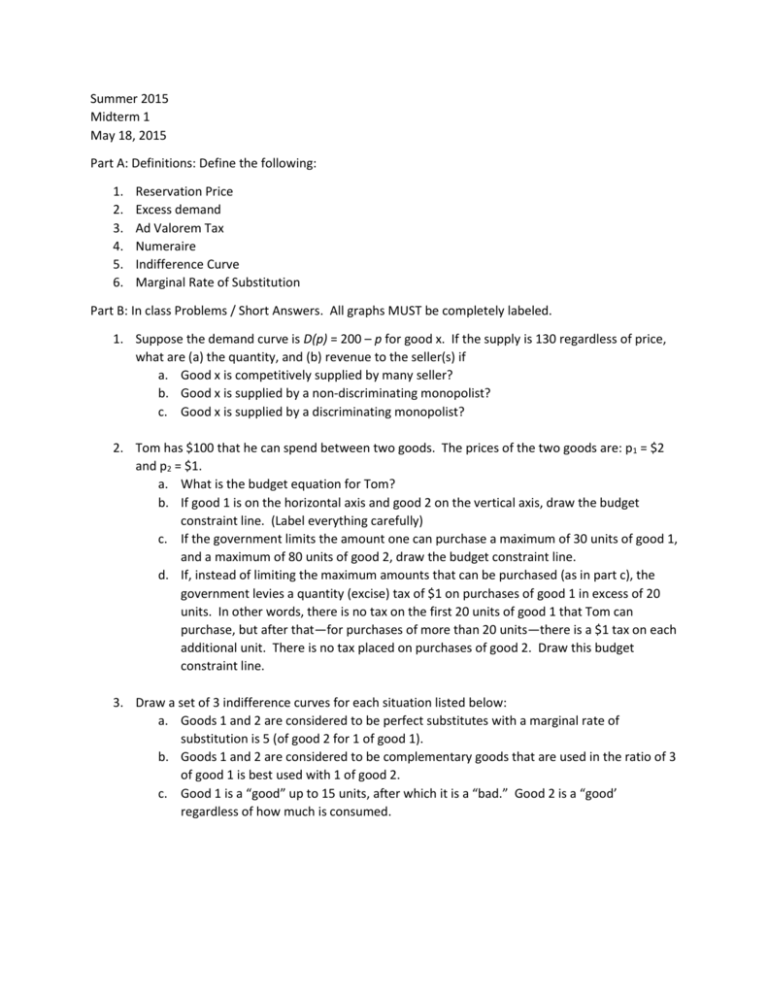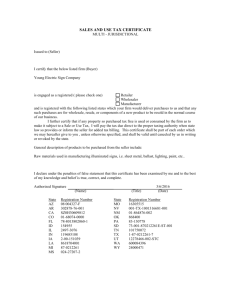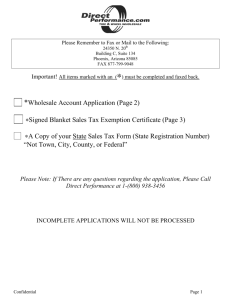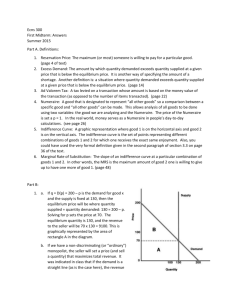Exam 1
advertisement

Summer 2015 Midterm 1 May 18, 2015 Part A: Definitions: Define the following: 1. 2. 3. 4. 5. 6. Reservation Price Excess demand Ad Valorem Tax Numeraire Indifference Curve Marginal Rate of Substitution Part B: In class Problems / Short Answers. All graphs MUST be completely labeled. 1. Suppose the demand curve is D(p) = 200 – p for good x. If the supply is 130 regardless of price, what are (a) the quantity, and (b) revenue to the seller(s) if a. Good x is competitively supplied by many seller? b. Good x is supplied by a non-discriminating monopolist? c. Good x is supplied by a discriminating monopolist? 2. Tom has $100 that he can spend between two goods. The prices of the two goods are: p1 = $2 and p2 = $1. a. What is the budget equation for Tom? b. If good 1 is on the horizontal axis and good 2 on the vertical axis, draw the budget constraint line. (Label everything carefully) c. If the government limits the amount one can purchase a maximum of 30 units of good 1, and a maximum of 80 units of good 2, draw the budget constraint line. d. If, instead of limiting the maximum amounts that can be purchased (as in part c), the government levies a quantity (excise) tax of $1 on purchases of good 1 in excess of 20 units. In other words, there is no tax on the first 20 units of good 1 that Tom can purchase, but after that—for purchases of more than 20 units—there is a $1 tax on each additional unit. There is no tax placed on purchases of good 2. Draw this budget constraint line. 3. Draw a set of 3 indifference curves for each situation listed below: a. Goods 1 and 2 are considered to be perfect substitutes with a marginal rate of substitution is 5 (of good 2 for 1 of good 1). b. Goods 1 and 2 are considered to be complementary goods that are used in the ratio of 3 of good 1 is best used with 1 of good 2. c. Good 1 is a “good” up to 15 units, after which it is a “bad.” Good 2 is a “good’ regardless of how much is consumed. Part C: Take Home: Due Tuesday, May 19 at the beginning of class. 4. In class it was claimed that if there are two goods, the indifference curve for those goods must have a negative slope. Rigorously prove that proposition. (Hint: show that if the indifference curves have a positive slope, there is a contradiction.) 5. “Quantity Discount” budget constraint: Suppose that Sam has $100 to spend between the purchases of two goods. Suppose that p2 = $1 always (you can think of good 2 as the Numeraire). The first 10 units of good 1 that are purchased have a price of $4; the next 20 units that are purchased are offered at a $2 discount (so the price per unit is $2); and if more than 30 units are purchases, those units in excess of 30 are offered at a $3 per unit quantity discount (so the price per unit is $1). a. Show Sam’s budget constraint on a graph. b. Suppose instead of the quantity discount, the seller chooses to price good 1 at $2.00 each for all units that could be purchased (i.e., there is NO quantity discount). Draw the budget constraint for Sam under this circumstance. c. Compare the two graphs for parts a and b. Which of these two pricing schemes do you think Sam would prefer? Explain. d. Why would a seller ever offer “quantity discounts” instead of just setting a single price? (Clarification of the quantity discount: For quantities 0 < x1 10, the price is $4; for quantities 10 < x1 30, the price is $2; for quantities 30 < x1 the price is $1.)









